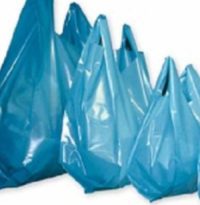
The “paper or plastic” conundrum that vexed earnest shoppers throughout the 1980s and 90s is largely moot today. Most grocery store baggers don’t bother to ask anymore. They drop the bananas in one plastic bag as they reach for another to hold the six-pack of soda. The pasta sauce and noodles will get one too, as will the dish soap.
Plastic bags are so cheap to produce, sturdy, plentiful, easy to carry and store that they have captured at least 80 percent of the grocery and convenience store market since they were introduced a quarter century ago, according to the Arlington, Virginia-based American Plastics Council.
As a result, the totes are everywhere. They sit balled up and stuffed into the one that hangs from the pantry door. They line bathroom trash bins. They carry clothes to the gym. They clutter landfills. They flap from trees. They float in the breeze. They clog roadside drains. They drift on the high seas. They fill sea turtle bellies.
“The numbers are absolutely staggering,” said Vincent Cobb, an entrepreneur in Chicago, Illinois, who recently launched the Web site http://Reusablebags.com to educate the public about what he terms the “true costs” associated with the spread of “free” bags. He sells reusable bags as a viable solution.
According to Cobb’s calculations extrapolated from data released by the United States Environmental Protection Agency in 2001 on U.S. plastic bag, sack, and wrap consumption, somewhere between 500 billion and a trillion plastic bags are consumed worldwide each year. Of those, millions end up in the litter stream outside of landfills—estimates range from less than one to three percent of the bags.
Laurie Kusek, a spokeswoman for the American Plastics Council, said the industry works with its U.S. retail customers to encourage recycling of plastic bags, which are in high demand from companies such as Trex in Winchester, Virginia, for use in building materials.
“We also feel it is important to understand that plastic grocery bags are some of the most reused items around the house,” she said. “Many, many bags are reused as book and lunch bags as kids head off to school, as trash can liners, and to pickup Fido’s droppings off the lawn.”
But like candy wrappers, chewing gum, cigarette butts, and thousands of other pieces of junk, millions of the plastic bags end up as litter. Once in the environment, it takes months to hundreds of years for plastic bags to breakdown. As they decompose, tiny toxic bits seep into soils, lakes, rivers, and the oceans, said Cobb….https://news.nationalgeographic.com/





























